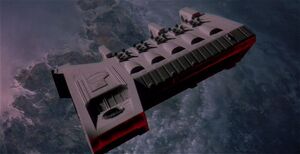
The BD-409 EEV (Emergency Escape Vehicle) is a small escape craft which is capable of carrying up to 16 passengers. It is 13.2 meters long with an L shaped configuration. At the edge of the craft is three large titanium support struts which hold ICC Standard retainer lugs for connection to it's mother ship. The underside is latched directly to the mother ship's escape hatches and access is made through these hatches via a large docking ring. The L shaped wedge holds the life support and drive section equipment which is accessed to the mother ship with a outboard umbilical up until the moment of it's launch. The vehicles hull is made from carbon alloy and ceramic composites and is able to withstand severe re-entry angles.
Functions[]
Certain mission profiles for the EEV can vary according to the mission situation. In an event of disaster aboard the mother ship, the decision to abandon is given by the Commanding Officer. But, because of interstellar space travel, the crew could be in hypersleep. If there is a crisis when the crew is in hibernation, then there might not be enough time for the crew to revive and the escape procedure would have to be handled automatically. In these situations then, the crisis management computers would bear the burden of escape of the mother ship. The ICC sets up the protocols for the crisis management computers to make sure that the evacuation of the ship is indeed initiated, when and only when, failure to do so would result in death. If this point is reached, then the computers on the mother ship will then send out a distress signal and then begin the escape procedures.
Immediately, all the units aboard the ship will begin to prepare for departure. EEV's are kept on a permanent 30 second standby, then at this point the escape vehicles computers will start up with the command menus and have the mission data downloaded to them from the mother ship's mainframe. On the mother ship, the computers will automatically disconnect the sleep capsules from the cryogenic umbiblicals and then the hypersleep capsules will be dropped into a series of tubes towards the nearest escape vehicle. As soon as the capsules are on board, the capsules are then installed into the EEV's life support systems and then the computer on the escape vehicle logs out of the mother ship's mainframe and initiates its own launch program.
At the time of launch, minus five seconds, if the override to stop the evacuation is not given to the mother ships computer, the retaining lugs that secure the EEV to the mother ship are then pulled and the outboard umbilical is detached. At launch minus two, the primary hull is latched to the docking ring release so the vehicle is attached by two explosive retaining bolts. At launch minus zero, the escape vehicles computers then blow the remaining two retaining bolts which allows the pressure of the ship's atmosphere on the escape hatch to flush the vehicle from the mother ship. The entire evacuation decision to abandon ship to it's initial launch takes 45 seconds.
As soon as the EEV is clear from the mother ship, the computers then start to initiate a search and rescue procedure, which is to turn on a powerful distress signal and a location beacon while scanning the immediate sector of space for suitable landing site or a rescue vehicle. The flight pattern and landing site would have been determined by the mother ships computers before it had launched and downloaded to the EEV. But, the EEV's computers are totally capable of overriding the mother ships decision should something better come up.
In other words, the EEV will attempt to home in on the closest navigational beacon such as a spacestation or a colony world and will set a course for that location. The BD-409's hyperdrive unit has a short range and the guidance systems will make sure that it'll retain a sufficient amount of fuel for the thrusters for an in-system docking or a powered entry to a colonized world. Since the life support capabilities are limited, it will keep the crew aboard in hypersleep for the journey, which it will monitor their status by the use of internal bio-function monitors and catscanners. Only wakening them for the terminal phase of the mission when the rescue is imminent.
If the rescue ship appears within the scanning range of the EEV, the onboard computers will try to hail the ship via their beacon and will try to maneuver itself to meet it. If there are no rescue ships around, the EEV will continue to its programmed destination and will try to attempt planetfall. The BD-409 has enough fuel for a single powered re-entry, but not near enough to sustain an orbit. So, it will follow the colonies landing beam directly down to the landing pad. If there is no beam, then the EEV will select a site from orbit and attempt a planetfall there.
The BD-409 is nothing but a 'dead-drop' vehicle which is designed to fall unpowered from orbit until it reaches a lower atmosphere, where it will use the thrusters to try to break it's descent. At this stage,the EEV deploys its tricycle undercarriage and 'flies' on its remaining fuel reserves for the landing site. If planetfall is made on an uncolonized world, the onboard systems may choose to keep the crew in hypersleep to await a rescue. But in most cases, the EEV will revive the crew once a touchdown is achieved. If the crew has survived the touchdown and find out that they have a long wait for a rescue, there are storage lockers which contain essential survival gear. A months rations, and first aid equipment and whatever else is necessary to keep the crew alive. There are enough supplies for each crew member on board so as to ensure that the crew won't have any kind of shortages.
The BD-409 EEV system has been noted for it's flexibility and reliability, but the nature of space disasters can make the egress from the mother ship quite a hazardous journey. Despite the advances in technology, there are still lives lost in an escape attempt from the mother ship. The escape procedures are quite elaborate that the malfunction of one thing, which is very likely when escaping from the mother ship, can become very harrowing to the entire evacuation. Even if everything goes correct, there is still no guarantee of a successful rescue from the immenseness of space. But, some chances are way better than none, and given the most lethal situations in space, it is quite hard to argue that the old wisdom used by old space explorers, 'When in doubt, bail out!'.
Trivia[]
- In Alien 3, it is never stated why the EEV crashes fatally on Fiorina 161 even though EEVs would presumably have to be fitted with some form of automated landing system (otherwise they would be essentially useless). However, the film was originally going to show how the Sulaco partially explodes as the EEV jettisons, with the concussion from this explosion damaging many of the escape unit's vital systems, including its guidance and landing capabilities.[1] This is why it slams into Fiorina's ocean instead of setting down gently on land. While cut from the film, this sequence was included in the novelization.[2]
- The Type 337 EEV is often (incorrectly) labelled the "BD-409 EEV". This alternative name originated in a section of the Alien 3 UK movie adaption comic Issue #2, which labelled the EEV a "Bodenwerke Gemeinschift BD-409". Ironically, the article was written by Lee Brimmicombe-Wood, who also penned the Colonial Marines Technical Manual where the official name comes from.
